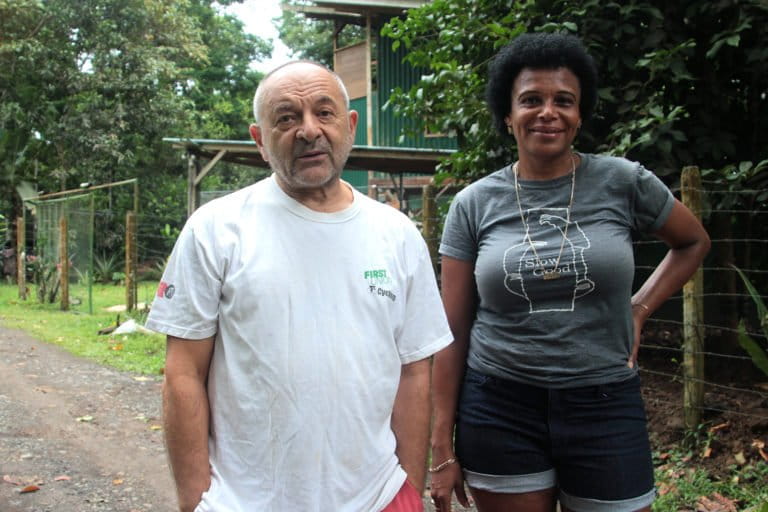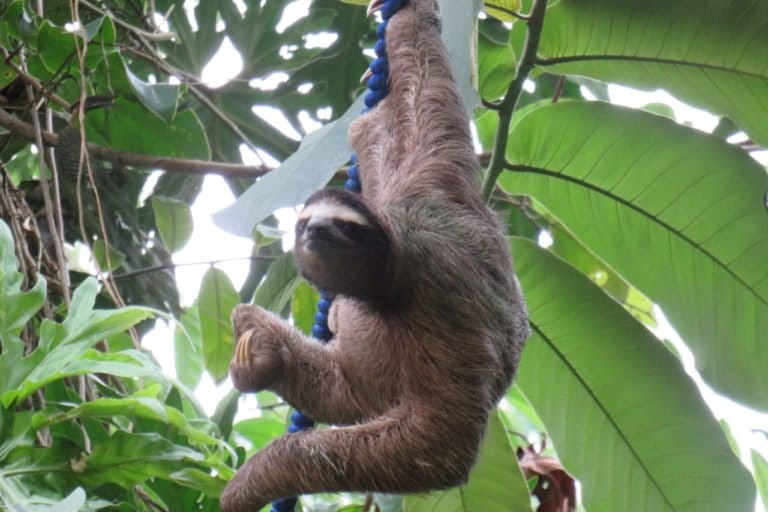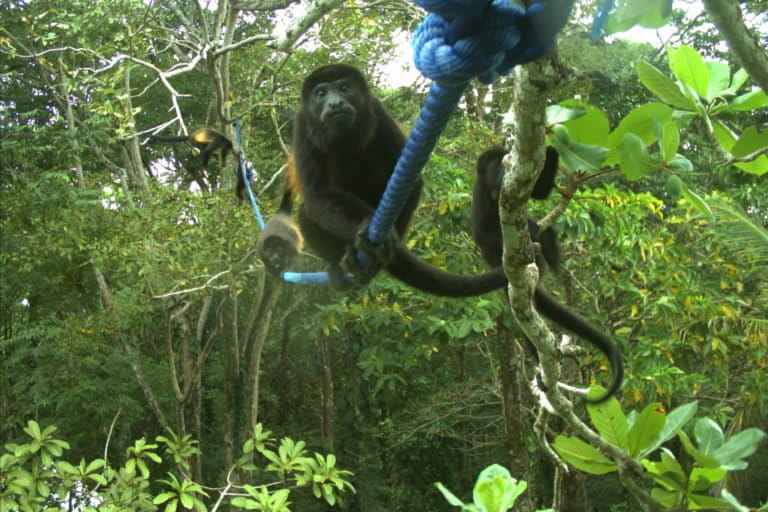
- The Sloth Conservation Foundation, created by British zoologist Rebecca Cliffe, is working to preserve the future of the world’s slowest mammals in Costa Rica.
- The group is building rope bridges to allow the arboreal animals to cross cleared patches of forest safely.
- Without these bridges, the sloths would have to come down to the ground to cross from one tree to another, putting them at risk of being run over by a car or attacked by dogs, or else they could be electrocuted going over power lines.
- The bridges are a temporary solution while the organization works on reforestation measures to ensure there’s sufficient suitable habitat for sloths.
Every morning, Anna Baltodano and Michael Chizkov look out from their terrace in search of sloths. Notoriously slow-moving and with fur the color of tree branches, the animals blend into the trees where they sleep, eat and move — ever so languidly — among monkeys, iguanas and toucans.
In the last few years, the forest that surrounds the couple’s terrace has been whittled away to make room for more houses, tourist cabins and roads.
“Sloths and other animals fall to the ground because much vegetation has been removed and they can’t move between the trees,” Baltodano says. She and Chizkov live in Playa Negra, 1 kilometer (0.6 miles) from Puerto Viejo, on Cota Rica’s southern Caribbean coast. “The last time there was a storm, a female sloth and her baby fell down. We rescued her and put her back up on a tree to protect her from cars and aggressive dogs,” Baltodano says.
“We’ve been living in this house for seven years and I wanted to buy the adjacent land to stop the tree felling,” Chizkov says. “When I finally got the money, someone else had bought it. It’s a shame. They’ve divided the land into small plots and they’re removing the trees.”

The couple decided they could still do something to help sloths: they planted more than 200 trees to support the wildlife. They picked trumpet tree (Cecropia obtusifolia) and yellow mombin (Spondias mombin), and asked the Sloth Conservation Foundation for help. The organization was founded in 2016 by British zoologist Rebecca Cliffe, an expert in sloths who moved to Costa Rica more than 10 years earlier. Costa Rica is home to two of the five known sloth species: the brown-throated three-toed sloth (Bradypus variegatus) and the Hoffmann’s two-toed sloth (Choloepus hoffmanni).
To find a solution to habitat fragmentation, the organization has promoted the installation of rope bridges in places where tree cover is fragmented. “For years, I’ve seen many slots get hurt because they crossed roads or were attacked by dogs,” Cliffe says. “The problems start when they have to go down to the ground. The way to keep them safe is to help them stay in the trees.
“They are unpredictable creatures,” she adds. “At the start I didn’t know if [the bridges] would work, but thanks to camera traps, we learned that they use them and they are useful.”
The tree bridges are a temporary solution accompanied by tree planting. Once the new vegetation has grown, recreating the habitat, the bridges can be removed.

Transforming a landscape
“There has been too much deforestation here,” says Tamara Ávila, the Sloth Conservation Foundation’s director of communications and finance. “All of this was a ‘super forest,’ there were barely any houses. The other day we took this route and I was scared by the change.”
With colleagues Francisco Rodríguez and Dayber Barker, Ávila is on her way to install a bridge in front of Baltodano and Chizkov’s house, less than a mile from her office. “I’ve been living here for seven years and I’ve seen the reduction of trees everywhere. Some fall during the storms, while others are cut to build and for fear of falling vegetation,” Ávila says.
On the way, they spot two iguana hunters with a slingshot; it’s illegal to hunt iguanas in Costa Rica. When the car gets closer, they stop. “It’s not the first time I see them and threaten to report them,” Ávila says.
Today, in spite of the tropical downpour that’s about to start, they’re going to install bridge number 114 — the first one was installed three years ago — to join a treeless area in front of the couple’s house. It might take hours to complete the installation. They throw a rope over the first tree with a sling, then secure it to the end of another rope that will constitute the bridge, and climb the second tree to complete the link.

“Local communities are aware, they see what’s happening, they miss seeing animals in the trees and ask us to collaborate so that wildlife can move around again,” says Rodríguez, who manages the foundation’s Connected Gardens project. “Habitat fragmentation creates genetic problems. Sloths are breeding only with individuals that are close. We are finding animals with only one finger or as many as four in species that usually have two or three.”
When the team finishes installing the rope bridge, Baltodano and Chizkov invite them for a traditional meal of rice and beans with chicken and a Caribbean sauce made with coconut and chili. Over lunch, they talk about the next bridge they’ll install and the next tree plantation of tropical almond trees (Dipteryx panamensis), soursop (Annona muricata) and whips-horse (Luehea divaricata).

Forests disappearing slowly
The loss of small patches of forests is visible to the residents of Costa Rica’s southern Caribbean coast.
“My heart breaks every day,” Cliffe says. “Here, two weeks ago they cut all the trees. I was used to seeing sloths in the branches.” She has a tattoo that shows her passion: a sloth with a baby in the tropical trees.
“They cut them illegally, as they do in Costa Rica. It’s not organizations that come and clear the area, it’s done at the individual level. A person cuts the trees so that they can build [on the land] and sell it to an external developer to make more money,” Cliffe says.
“We need to consider that there are no economic incentives for those who keep the rainforest in their territories. That’s why it’s important to build the tree bridges,” Cliffe adds. “This plot of land isn’t connected to anything anymore and the sloths need to go down to the ground to cross it.”

“People are building very fast here, there are full residential complexes planned,” says Rodríguez, who has worked in environmental conservation in the region for years. “We are in a border area, there’s a lot of illegal [activity] and few controls. We need to press institutions to create a regulation.”
Costa Rica enjoys widespread forest cover thanks to a proliferation of protected areas. But the loss of multiple small patches of forest still registers.
“On the one hand, deforestation in the last seven years has tended to zero, with less than 3,000 hectares [7,400 acres] per year,” says Héctor Arce Benavides, who directs Costa Rica’s REDD+ strategy to reduce emissions from deforestation and forest degradation. “On the other hand, in our analyses, we’ve noticed the growth of the activity we call forest degradation: the extraction of biomass without a need of land-use change.
“These are small forest areas that are hard to assess with satellite images [because of] the extraction of big tress in the forest periphery,” Arce says.

Arce says greenhouse gas emissions as a result of forest degradation doubled in the past decade.
“We went from 1.3 million tons per year [in the period from 1998-2011], to 2.5 million tons in 2018 and 1029,” he says.
Local experts say the loss of forest cover has an economic impact, by making it increasingly difficult for people who own small forest plots to generate an income.
“This risk [of forest degradation] is established by a complex social dynamic: we have the land distributed to small- and medium-sized landowners who see no future in the development of their property,” says Felipe Carazo, manager of forest resources and a member of the Tropical Forest Alliance (TFA).
For these landowners, Carazo says, there are lucrative short-term gains to be made from logging. But the long-term fallout is that this chipping away at the forest “breaks up biological corridors [and is] why landscape management needs to consider these social factors.”

Threading a biological corridor through urban areas
Along Costa Rica’s southern Caribbean coast, the effort to string together the biological corridor threads through bars, restaurants and beachside hostels, where tourists and locals say they see sloths almost daily.
The idea is to continue along the beaches and forests, eventually linking up to the Jairo Mora Sandoval Gandoca-Manzanillo Mixed Wildlife Refuge.

“The last bridge that we were going to install was going to pass above the road and the power cables,” Ávila says. “It’s one more danger for the sloths that live close, a mother and her baby that we call Luna and Sol [Moon and Sun], and that are facing possible electrocution on the electric lines.”
But before the Sloth Conservation Foundation team could install the bridge, “the trees were cut and we couldn’t do anything,” she says.
On some the bridges that they’ve already built, the team has installed camera traps, which have helped them verify the presence of 14 species using the bridges. These include mantled howler monkeys (Alouatta palliata), white-faced capuchins (Cebus capucinus), and opossums. The foundation says the challenge is to build bridges in deforested areas all over Costa Rica and across South and Central America, with the support of governments and aided by the strengthening of environmental laws.

Can humans and wildlife coexist?
A young sloth sleeps on a tree branch, hugging a trumpet tree leave. A few steps away, the waves crash on Playa Negra. Dog walkers passing nearby haven’t noticed the sloth, which conservationists have named Mango, thanks to its camouflage. Amelia Symeou, the ecology coordinator at the Sloth Conservation Foundation, spots it, though. She tracks seven individuals daily using their satellite-tagged collars. This monitoring of the population, bridges and camera traps is part of the foundation’s conservation strategy for the species.
In Costa Rica, there’s been little research about sloths, and no data on population estimates. What Rebecca Cliffe and her organization are doing in monitoring the sloths has therefore been a challenge, compounded by other difficulties and stereotypes that they’ve had to overcome.
“When I started working with sloths, I was only 18 years old and I was a woman coming to Costa Rica,” Cliffe says. “They didn’t take me seriously, not only in Costa Rica, also in my country, the United Kingdom.
“I still struggle,” she adds. “People are surprised when I tell them what I’ve done in the past and what I can do. I’m going to go on. The results of my work speak for themselves through the years. That’s what matters.”

Finding a way for wildlife and economic development to coexist in the region is a crucial challenge. “People need to use the land they own and we understand that,” Cliffe says. “But instead of chasing them, we want to work with the communities as a team.
“Sloths are trying to survive next to humans, we need to guarantee access to the trees, their refuge and food. If we do this, I’m sure we’ll still have them around in the future,” Cliffe says. “And also, taking care of biodiversity means more tourists and more revenue. It’s a win-win situation for nature and the local communities.”

Banner image of a sloths crossing a rope bridge installed as part of the Connecting Gardens initiative by the Sloth Conservation Foundation.
This story was reported by Mongabay’s Latam team and first published here on our Latam site on Jan. 27, 2022.
Bridges in the sky carry sloths to safety in Costa Rica
Source: Trends News

0 Comments